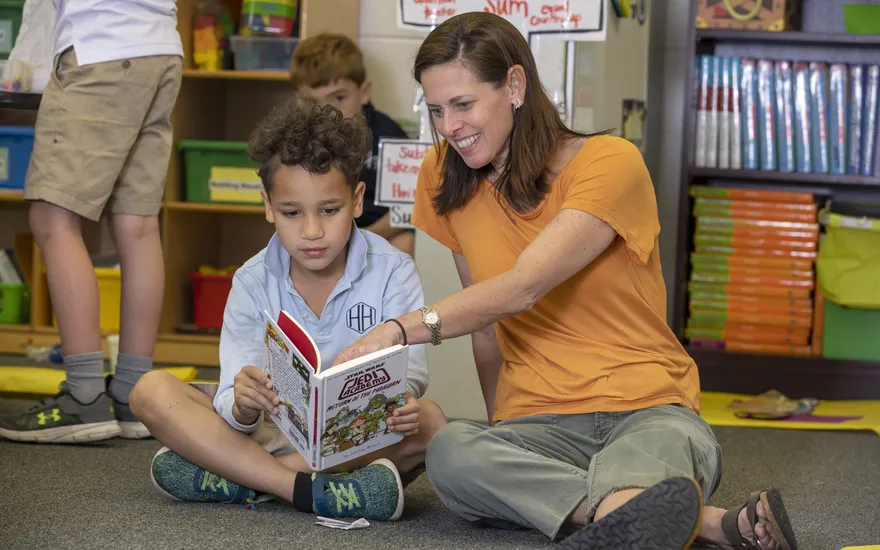Be a Cheerleader, Not a Coach

Red, blue, yellow. A, M, or X. 3.1, 4.5, 6.2. Lexile, DRA or RR. Sometimes it seems there are as many different ways to assess student reading levels as there are stars in the sky, and parents often feel anxious about where their student falls on the chosen scale. Parents know that reading skill is often directly linked to student success, so from Kindergarten forward it feels as though there is a lot riding on getting our children as far along that sliding scale as possible each year in order to give them the best chance at success.
At Heathwood, teachers take reading success very seriously too. From pre-reading in the EC, through emerging and developing reading in the LS, and on through greater levels of comprehension and textual complexity in the MS and US, students are regularly assessed to chart their reading progress. At each grade level, teachers provide a variety of reading materials at and above each child’s reading level as they develop throughout the year. Classroom reading is geared towards supporting and challenging readers to enable them to reach their full potential as readers at each grade level.
What does that mean for parents? It means that when it comes to growing great readers, they get to do all the fun stuff! You can relax a bit and let home be the place where reading is about free choice, trying new things, and togetherness.
Free Choice
Raise your hand if you like to be told what to do. Yeah--didn’t think so. Well, at school, even though teachers provide as much variety and choice as they can, reading is based on specific goals, so students have less in the way of free choice in what they read. This is important from a curricular standpoint, and it also means that parents have a lot more leeway with reading choices at home. Whether because their brains are tired, they want to read a comforting favorite, or their teacher doesn’t completely understand the importance of staying up with the latest Bird & Squirrel book, sometimes students just want to read something “easy” at home. And that is fine. It has been proven time and again that reading is reading is reading; that is, all reading helps build habit, fluency and stamina. Just like we adults don’t want to read War and Peace all of the time, and sometimes just want to read the latest John Grisham or People Magazine, it is important to allow students to choose their recreational reading on their own.
Trying New Things
That’s not to say, however, that students should only read The Last Kids on Earth or Diary or a Wimpy Kid over and over again forever. I always tell my students, if you had never tried anything new, you’d still only be reading Pete the Cat! You have to try new books to see what you’ll like next! But that also doesn’t mean you have to leave all your old favorites behind. Many of us like to read our old favorites over and over (Ferdinand forever!). Encourage your child to mix in some new titles with their favorites when you go to the library, bookstore or Kindle store. Mix in different genres, and also formats: chapter books, graphic novels, audio books, fiction and nonfiction books, magazines, and comics--all are equally great at developing skill and a love of reading! Be sure to model this behavior yourself--when you see a new novel mentioned someplace that you want to read, or picking up a new magazine or nonfiction book about a new interest--our children watch what we do to see what behaviors we value.
Togetherness
Speaking of trying new things, the easiest way to do this is by reading together as a family. Research has shown that reading aloud has clear benefits at least through the eighth grade, and possibly beyond . Even high school students will benefit from reading together as a family; if each person reads something different, you can share interesting bits from your selection, or recommend titles to one another. Plus, it is a great way to spend time together. If you allow each family member to have a turn at choosing what to read, you will naturally read a wide variety of genres, themes, and formats. You will build aural vocabulary (which makes print reading easier), comprehension, and the habit of making time to read. Win, win, win!
I encourage you to think of your reading role at home as cheerleader even more than as coach. Allow your child’s teachers to guide you in their curricular reading goals, while you encourage the joy of reading as a lifelong activity. By being excited about reading, by encouraging your child along their own individual reading path, and by modeling reading as a worthwhile activity, you will do so much toward creating a lifelong reader who will reap benefits their entire life.
Happy Reading!